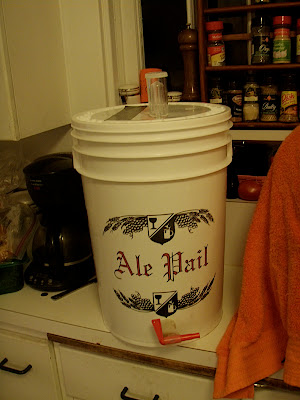ViperMan
Well-Known Member
This has happened too many times for not to start asking questions...
I brewed a beer that has just had nothing but problems - you can follow the original thread here.
When I first decided to dilute the beer and rack to a secondary, my satellite test-sample bottle (referred to as SV from here-out) read 1.035. I diluted, racked, and drew a new sample which read 1.043... "WTF?" I wondered... "Well, whatevs..." I took a new SV sample.
A few days later the (new) SV started to ferment again. It dropped from 1.043 down to a 1.036 or so, maybe a smidge less - I forget the specifics. However the airlock on my FV hadn't budged. So after 10 days (and with some White Labs 090 "starting") I popped the lid on the FV and took a sample. It read 1.043 - it hadn't done squat. For the second time, my SV had fermented further than my FV. I pitched the 090 which immediately began fermenting vigorously, tossed the SV sample and took another one.
Over this past weekend, with my (third) SV holding steady at 1.020 for about 3 days, I decided it was time to bottle. I did notice every once in a while I'd hear a bubble from the airlock of my FV, but figured it was caused my vibration since it was on a table to keep it in the warmer temps of the room for the benefit of the 090.
So on Sunday I popped the lid on the FV and decided to take another quick reading... 1.026. SV still read 1.020. THREE TIMES NOW my SV has fermented further than my FV and I'm at a total loss. I can't keep wasting samples of this stupid beer!
Does anyone have ANY idea why this keeps happening?? Every time I take a new sample I put it in a clean plastic bottle. They never pick up any taste of bacteria (though I realize it'd probably be too small to detect...) I've never had this issue with any other beer, and I have no idea what's going on.
By now I could have brewed two more of these beers... I frankly don't care anymore...
I brewed a beer that has just had nothing but problems - you can follow the original thread here.
When I first decided to dilute the beer and rack to a secondary, my satellite test-sample bottle (referred to as SV from here-out) read 1.035. I diluted, racked, and drew a new sample which read 1.043... "WTF?" I wondered... "Well, whatevs..." I took a new SV sample.
A few days later the (new) SV started to ferment again. It dropped from 1.043 down to a 1.036 or so, maybe a smidge less - I forget the specifics. However the airlock on my FV hadn't budged. So after 10 days (and with some White Labs 090 "starting") I popped the lid on the FV and took a sample. It read 1.043 - it hadn't done squat. For the second time, my SV had fermented further than my FV. I pitched the 090 which immediately began fermenting vigorously, tossed the SV sample and took another one.
Over this past weekend, with my (third) SV holding steady at 1.020 for about 3 days, I decided it was time to bottle. I did notice every once in a while I'd hear a bubble from the airlock of my FV, but figured it was caused my vibration since it was on a table to keep it in the warmer temps of the room for the benefit of the 090.
So on Sunday I popped the lid on the FV and decided to take another quick reading... 1.026. SV still read 1.020. THREE TIMES NOW my SV has fermented further than my FV and I'm at a total loss. I can't keep wasting samples of this stupid beer!
Does anyone have ANY idea why this keeps happening?? Every time I take a new sample I put it in a clean plastic bottle. They never pick up any taste of bacteria (though I realize it'd probably be too small to detect...) I've never had this issue with any other beer, and I have no idea what's going on.
By now I could have brewed two more of these beers... I frankly don't care anymore...



